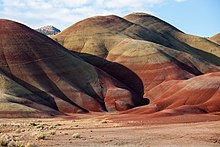Painted Hills


The Painted Hills is a geologic site in Wheeler County, Oregon that is one of the three units of the John Day Fossil Beds National Monument along with Sheep Rock and Clarno. It totals 3,132 acres (12.67 km2) and is located 9 miles (14 km) northwest of Mitchell, Oregon. The Painted Hills are listed as one of the Seven Wonders of Oregon.[1] Painted Hills is named after the colorful layers of its hills corresponding to various geological eras, formed when the area was an ancient river floodplain.
Geology[]
The Hills' colors originate from 35 million years ago, when this area was an ancient river floodplain.[2] The colored bands are due to changes in climate that occurred as they were distributed through time. As the climate changed to a more tropical setting with distinct wet and dry seasons, reddish and yellowish layers formed that are made up of laterites, soils rich in iron and aluminum. Red soils come from a more tropical period, while the yellows are from a drier and cooler time. The red coloring is laterite soil that formed by floodplain deposits when the area was warm and humid.[3] The darker, black soil is lignite that was vegetative matter that grew along the floodplain. The grey coloring is mudstone, siltstone, and shale.[4]
An abundance of fossil remains of early horses, camels, and rhinoceroses in the Painted Hills unit makes the area particularly important to vertebrate paleontologists.[5]
Recreation[]
The Painted Hills are listed as one of the Seven Wonders of Oregon.[6] The Painted Hills unit is open year-round with access for all visitors, but recreation can take a toll on the landscape; visitors who step off the trails can disrupt the naturally-occurring mineral layers, and damage the hills' visible features. There are several well-marked trails for visitors,[7] who are encouraged to take a pledge to stay on the trails at all times: 'Don't Hurt the Dirt',[8] and 'Leave No Trace'.[9]
In 2015, the annual visitor count at the Painted Hills rose from 45,849 to 74,873.[10]
On August 21, 2017, the Great American Eclipse passed directly over the park, allowing visitors a duration of totality of just over 2 minutes, 4 seconds.[11]
Gallery[]




Bands of laterite give Painted Hills in the John Day Fossil Beds National Monument near Mitchell, Oregon their colorful appearance.
References[]
- ^ "Painted Hills Unit". John Day Fossil Beds National Monument. U.S. National Park Service. Retrieved 2006-12-01.
- ^ Patowary, Kaushik. "Painted Hills of Oregon". Amusing Planet. Retrieved 2019-12-04.
- ^ "John Day Fossil Beds National Monument, Oregon". U.S. Geological Survey. Archived from the original on 2006-09-23. Retrieved 2006-12-01.
- ^ "John Day Fossil Beds National Monument, Oregon". U.S. Geological Survey. Archived from the original on 2006-09-22. Retrieved 2006-12-01.
- ^ Alt, David; Donald W. Hundman (1995). Northwest Exposures: A Geologic History of the Northwest. Mountain Press. pp. 227–231. ISBN 0-87842-323-0.
- ^ "Painted Hills Unit". John Day Fossil Beds National Monument. U.S. National Park Service. Retrieved 2006-12-01.
- ^ Patowary, Kaushik. "Painted Hills of Oregon". Amusing Planet.
- ^ Kimberly, Mailing Address: 32651 Highway 19; Us, OR 97848 Phone:987-2333 Contact. "DontHurtTheDirt - John Day Fossil Beds National Monument (U.S. National Park Service)". www.nps.gov.
- ^ "Protect the Outdoors - Leave No Trace Center for Outdoor Ethics". Leave No Trace.
- ^ Group, Kathy Aney EO Media. "Painted Hills live up to billing". Blue Mountain Eagle.
- ^ "Oregon eclipse". Total solar eclipse of Aug 21, 2017. Retrieved 11 November 2018.
External links[]
| Wikimedia Commons has media related to Painted Hills. |
- "John Day Fossil Beds". National Park Service. Retrieved 2008-11-09.
- "Image Gallery". Marius Schilder. Archived from the original on 2013-01-24. Retrieved 2010-07-13.
[1] – Painted Hills
- John Day Fossil Beds National Monument
- Protected areas of Wheeler County, Oregon
- Landforms of Wheeler County, Oregon






